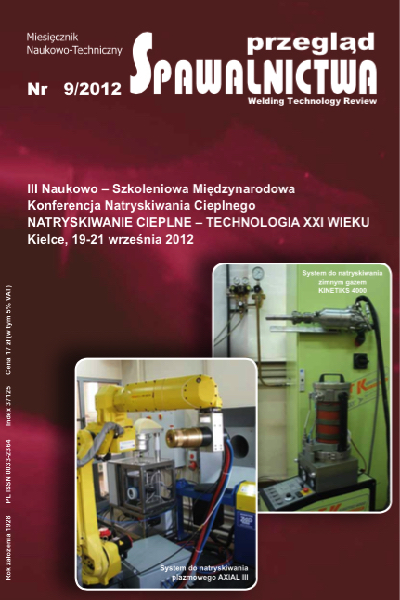Wpływ rodzaju układu rozpylającego i sposobu natryskiwania na koszty wykonania powłok natryskiwanych łukowo
Main Article Content
Abstract
W artykule przedstawiono wyniki badań wpływu odległości natryskiwania, kąta natryskiwania, napięcia łuku, ciśnienia powietrza rozpylającego, rodzaju materiału powłokowego oraz rodzaju układu rozpylającego w pistoletach łukowych na wielkość strat materiału powłokowego, a więc koszty materiałowe. Badania wykonane zgodnie z normą PN-EN ISO 17836 wykazały, że przy nadmiernym zwiększeniu odległości natryskiwania koszty materiałowe mogą wzrosnąć nawet dwukrotnie. Stwierdzono, że dzięki zastosowaniu stopu Zn-Al zamiast Zn można koszty materiałowe zmniejszyć o ok. 10÷12%.
Cost of arc sprayed coatings depending on the type of atomizing chamber and some of spraying parameters
Abstract
The test results of the influence of spraying distance, spraying angle, arc voltage, atomizing air pressure, metal type and atomizing chamber type in arc spraying gun on materials loss and coating costs are discussed. Tests carried out according to PN-EN ISO 17836 showed that too big spraying distance could increase material loss even twice. Replacing of Zn by Zn-Al alloy may decrease the costs of about 10÷12%.
Downloads
Article Details
Creative Commons CC BY 4.0 https://creativecommons.org/licenses/by/4.0/
Welding Technology Review (WTR) articles are published open access under a CC BY licence (Creative Commons Attribution 4.0 International licence). The CC BY licence is the most open licence available and considered the industry 'gold standard' for open access; it is also preferred by many funders. This licence allows readers to copy and redistribute the material in any medium or format, and to alter, transform, or build upon the material, including for commercial use, providing the original author is credited.
References
Kwiatkowski L., milewski W.: Powłoki metalowe w ochronie przed korozją konstrukcji stalowych. Informator Gospodarczy PIKS 2009.
PN-EN ISO 14713-1:2010 Powłoki cynkowe Wytyczne i zalecenia dotyczące ochrony przed korozją konstrukcji ze stopów żelaza Część 1: Zasady ogólne dotyczące projektowania i odporności korozyjnej.
Schweizerische Fachstelle Feuerverzinken (www.hdg-online.net).
Thermal Spray Coatings-Past, Present & Future Ted Call District Sales manager KTA Tator, Inc. Pittsburgh, Pennsylvania, USA.
DOT Wirginia 6-02.5 (13) OPT3FB6 Corrosion Protection,
August 2010.
Metallized coatings for corrosion control of naval ship structures and components. national Research Council (U.S.), National Materials Advisory Board. Washington, D.C.: national Academy Press, 1983.
Mühlberg K.: Corrosion Protection for Windmills Onshore and Offshore. Hempel (Germany Ltd. Cologne, August 2004.
Rahrig P.: Analyzing costs of galvanizing structural steel, Plant Engineering, October 2004.
Roebuck A.H., Brevoort G.H.: Coating Works Costs: Computer Application and Inspection, CORROSIOn/86, national Association of Corrosion Engineers, Houston, Texas, 1986.
Milewski W., Kobus J., Olbrycht A.: Koszt wykonania i eksploatacji powłok metalowych i metalowo-malarskich chroniących konstrukcje stalowe przed korozją. V Konferencja Naukowo-Techniczna PSK, Współczesne technologie przeciwkorozyjne, 2011.
